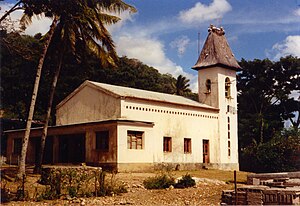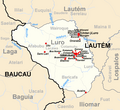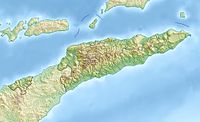 | ||
| Tutuala | ||
| District | Lautém | |
|---|---|---|
| Residents | In sub-district: 3,847 (2010), in Suco: 1,339 (2004) | |
| no value for residents on Wikidata: | ||
| no tourist info on Wikidata: | ||
| location | ||
| ||
Tutuala is a place in East Timors Lautém district at the eastern end of the island, the Cabo Cutcha. The small town is the starting point for excursions to the island Jaco and in the Nino Konis National Park. There are also cave paintings several thousand years old, which are still young compared to the traces of the first settlement on the island. Even if you feel like you are at the end of the world; It is from here that the ancestors of the Aborigines probably followed suit Australia.
background
geography


The place Tutuala is the capital of the subdistrict of the same name, which consists of the eastern tip of the island of Timor and the small island of Jaco. The entire sub-district is part of the Nino Konis National Park, as is the marine area off the coast. The is on the western border Lagoa Ira Lalaro (also Suro-bec), East Timor's largest lake, which, however, shrinks considerably in the dry season. The landscape is characterized by savannahs, on which horses, buffalo and cattle graze, and forests with a rich bird life. The north coast in particular drops steeply to the sea, but in contrast to other parts of the country, no mountains shape the landscape here. But there are a few Fatu, the steep slopes typical of the country. The west of the sub-district is part of the Fuiloro Plateau, the remnant of a lagoon of a prehistoric atoll. Due to its large area, it falls imperceptibly to the south, from a height of 700 m to 500 m. To the south, the plateau is delimited by the Paitcheau massif, which again reaches 960 m.
Like so many other places in East Timor, Tutuala is not a closed place, but a very loose collection of huts and small houses. Some are made of stone with a corrugated iron roof, others are made of clay and straw. The other settlements in the sub-district look no different. Mehara, the second largest town, is halfway between Bauro and Tutala. Before that you can still get through Poros. South of the Ira Lalaro is the village of Malahara, to which something like a road leads from Mehara. If you're lucky with the way, you can even go to Lospalos go on.
The Paitchau mountain and the Ira Lalaro and the Jaco Island have been declared Important Bird Areas by BirdLife International.
population
The sub-district has 3,847 inhabitants (2010), the Suco 1,339 (2004). The largest language group are the speakers of the national language Fataluku. The last speakers of the national language Makuva, the only native Malayo-Polynesian language in the district, live in Suco Mehara, west of Tutuala. In the first few years, the children learn the official language Tetum at school, with further training also the official language Portuguese, which some old people still speak from the colonial days. English brought foreign troops and police officers to East Timor in recent years. Bahasa Indonesia, the language of the former occupiers, does not meet with approval everywhere.
getting there
Mikroléts, minibuses, serve as public transport that connects Tutuala with the district capital Lospalos. The bus can be very full, so a large backpack can cause difficulties. The Mikroléts stop near the primary school (Escola Primaria Tutuala) in Tutuala, in Lospalos the market is the stop.
If you have a rental car, you can reach Tutuala via the slopes (approx. 25 km as the crow flies) from the overland road in Bauro (between the town Lautém and Lospalos) branches off.
By boat
If you are traveling with your own boat, you can anchor off the coast. From the beach across from Jaco Island, a road leads to Tutuala.
mobility
If you want to go to the beach, you shouldn't trust the statement that you only need 20 minutes on foot from Tutuala. It is five kilometers as the crow flies and the nine-kilometer-long sandy track that winds its way down the 70 meters in altitude through the forest is regularly damaged by heavy rainfall. At best, you can drive down here in an all-terrain vehicle. Anyone who sets out on the shoemaker's pony must definitely take enough water with them to drink. The same applies to mountain bikers who later want to ride up the slope again.
Tourist Attractions


- Tutuala Church. The tower of the small village church is adorned with the roof of an Uma Lulik, the traditional holy houses of East Timor, which have since become a national symbol.
- Ile Kére Kére and O Hi caves. In the limestone caves near Tutuala Beach there are paintings, the exact age of which has never been determined. Estimates go from 2,000 to 6,000 years ago. They show hunting scenes, animistic symbols such as turtles and other animals, boats and hand prints. The shape of the boats suggests an Austronesian origin, which contradicts the Papuan origin of most of the languages in the district. It is unclear whether the drawings represent the artists' boats or boats passing by. There are also pictures of horses that, like the other farm animals on Timor, were introduced by early immigrants. The main cave Lena Hara, a little further south, was discovered in 1963. Scientific investigations could prove settlements up to 30 to 35,000 years ago. A 10,000 year old stone engraving was found here in 2009, showing a face. Danger! The way to the caves is long, arduous in the heat and of course not signposted. Whoever goes there will, however, have a wonderful view of the sea and the island of Jaco.
- Jerimalai Cave. The oldest traces of human settlement on Timor were discovered in 2006 in this limestone cave near Tutuala. They are at least 42,000 years old. The findings corroborate the theory that modern humans spread from Asia to Australia on the southern route across the Lesser Sunda Islands.
- Old fortifications. There are several old fortifications around Tutuala (lata irinu), with which the Fataluku used to protect their settlements. Several walls and foundations have been preserved. Located directly at Tutuala Haro, west Lochami. At Ile Kére Kére is located Mua Mimiraka, at Lena Hara Ili Mimiraka. Further settlement remains are Lorilata, Tutunchau and upper and lowerLopomalai.
activities

- Jaco Island and Valu Beach. The Valu beach, with its white sand, is a tropical dream. The beach on Jaco Island is no different. In the past, entry to the island, which is considered sacred, was forbidden, but today you can have fishermen drive you over for a few dollars. Or you can go fishing with them. The sea here is ideal for snorkeling. The beach is also a sanctuary that is equipped with several totems. Here are remnants of the old popular belief, which is still very much alive under the dominant Catholic faith. This can also be seen in the cemeteries of Tutuala and other places in East Timor, where buffalo skulls can be found peacefully next to crosses on the graves. (w: Jaco (East Timor) and w: Beach of Valu).

- Nino Konis National Park. The national park was founded a few years after East Timor gained independence and named after the freedom fighter Nino Konis Santana, who was born in Tutuala. It covers 68,000 hectares of land and 55,600 hectares in the sea. Nature and the cultural and historical heritage in the region are to be protected. These include coral reefs and the largest remaining intact tropical lowland and monsoon rainforest in the region. There are numerous orchids in the rainforest. In addition, the area has mythological significance for the population and there are historically important places from the Portuguese colonial times and the time of the Japanese occupation during the Second World War. The national park is home to 25 species of birds that can only be found on Timor and neighboring islands, including the endangered yellow-cheeked cockatoo (Cacatua sulphurea) and the green Timor pigeon (Treron psittaceus). A dream for amateur ornithologists. Mane deer (Rusa timorensis) live in the forests, saltwater crocodiles, sea turtles on the coasts and many corals and marine animals in the sea. Once a year are in certain places on the coast Meci worms collected. The harvest of this maritime annelid marks the beginning of a new annual cycle for agriculture and is celebrated with festivities in the villages.

- Mechi festival. At the Valu Beach takes place twice a year the Mechi (w: Mechi) instead of. The smaller one takes place in the last lunar quarter of February Mechi kiik and at the new moon in March the big one Mechi boot instead of. The sex segments of the maritime Meci worm (w: Samoa-Palolo) collected as part of a big festival, which are released on these days by the worm to multiply. There is dancing and singing. The worms are marinated raw with chilli and lemon and are considered a delicacy in the form of a salad. In addition, fish, corn, rice, beans, palm wine and betel nuts are served at the feast. The ritual offerings will be made the day after the harvest fan, called "feeding the spirits".
shop

There is a small village shop, but it doesn't have much to offer. You don't even get packaged drinking water, then you just take a few cans of Coca Cola instead.
The local handicrafts offer the traditional, woven cloths of Timor, which here often show crocodile motifs. The same goes for wood carvings. The crocodile plays an important role in the island's creation myth. The shells of turtle eggs are also decorated with engravings, but this souvenir is just as forbidden as the shells of tropical mussels or corals. The ban applies to both exports from East Timor and imports to Europe. Anyone caught can expect a hefty fine.
kitchen
As a guest, you can also eat in the guest house. Otherwise, self-sufficiency is the order of the day.
nightlife
There is not any.
accommodation

At the end of the village, where the land slopes steeply to the sea, there is a villa from the Portuguese colonial times. In the past, UN police officers were housed here, today there is a small guesthouse (pousada) with simple rooms and an even simpler bathroom. Water is drawn daily from the river into a large basin, but you do not sit in it. You draw water from it and wash outside. You should be economical so that there is enough water for everyone. You only become aware of the luxury of running water when you manage to wash yourself completely with two cups of water.
There is now an Eco-Village on the beach of Valu that offers tourists permanent accommodation.
In the meantime there are said to be other residents of Tutuala who rent rooms to tourists.
Practical advice
The pension is the point of contact for tourists. Other ways to get information should be the police station, the school and the pastor of the church. The police were trained by UN personnel, so they may speak some English. At school, you may be able to get on with Portuguese with the teachers.
The caves in particular, but also many other interesting places, are sacred places of the traditional, animistic religion of Timor. Almost all of the Timorese are now nominally Catholics, but that doesn't mean that the old taboos no longer apply. Therefore, you should always make sure that you get permission to visit from the locals. The advantage of this is that you usually get a guide who can show you things that you would otherwise miss. The few dollars it costs are money well invested.
trips

- Mehara. The second largest village in the sub-district halfway to Tutuala. There are still many traditional huts here. (w: Mehara).
- Lagoa Ira Lalaro. The lake with its swamps is a paradise for bird life. Over 200 resident species have been counted here. In 2007 a hitherto unknown snake necked turtle was discovered here. Danger! It is essential to protect yourself from mosquitoes, also because of the communicable diseases. Estuarine crocodiles also live in salt water. (w: Ira Lalaro).
- Paitchau massif. The mountains reach about 960 m and demarcate the high plateau from the south coast, which is relatively unpopulated. Pure nature with an impressive world of birds. (w: Paitchau).
Maps of the other sub-districts of Lautém

Iliomar

Lautém

Luro
Web links
- The w: Portal: East Timor contains articles on various locations in the Tutuala sub-district.
- Large format map of the Lautém district (Archived version of June 30, 2007 in the Internet Archive archive.org) (Attention: PDF with 7.17 MB)
- The unofficial guide to East Timor: Tutuala and the eastern tip (English)
- BirdLife International: Monte Paitchau (English)
- Brochure of the Nino Konis Santana National Park (English)





